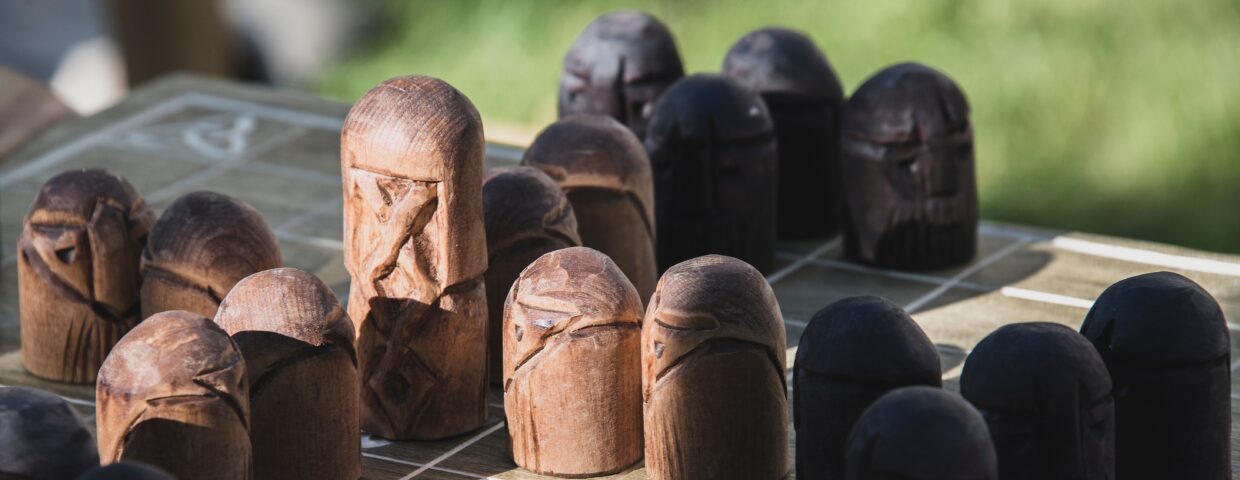The Evolution of RPG
A Journey From Tabletop to Digital

Have you ever wondered where role-playing games (RPGs) came from? To understand this universe and project where it will lead us in the future, fellow adventurers, let’s take a journey through time and explore further the origins and evolution of this iconic genre.
The Beginning of Everything
Believe it or not, RPGs actually date back to the 16th century! That’s right – people have indeed been using their imaginations to create characters and embark on adventures for centuries.
Back then, storytelling and role-playing games were all the rage in Europe. People would gather in groups to act out fictional characters and tell stories, thus leading to improvisational theater’s development. This game-changer allowed people to create stories on the fly and act out different characters (and you can also incorporate this in your campaigns today, reading this other post).
Some of the most famous authors and artists of all time were certainly involved in improvisational theater. And I bet you’ve heard of them.
Storytelling and Improvisational Theater
One such artist was William Shakespeare, famous for his plays, but did you know he also enjoyed improvisational theater? It’s true! Shakespeare was part of an improv troupe called The Lord Chamberlain’s Men, which generally performed at the Globe Theatre in London. Another famous artist involved in improvisational theater was Moliere, the French playwright who wrote some of the most popular comedies of the 17th century. He also performed in a troupe called The Illustrious Theater, which specialized in improvisation.
People began developing games incorporating storytelling and improvisational theater elements as time passed. Later, in the 19th century, games like “Charades” and “Twenty Questions” became popular, where players would act out or ask questions to guess a word or phrase. These games encouraged creativity and imagination and were undeniably a precursor to modern RPGs.
The Rising of RPGs
In the early 20th century, tabletop wargaming became popular, where players would use miniatures and models to simulate battles. People have been using their imaginations to create fictional characters and embark on adventures for centuries. But it wasn’t until the 1970s that RPGs, as we know them today, started to take shape.
In 1974, a group of friends – just like all adventurers! – created the first tabletop RPG, Dungeons and Dragons (D&D). It was a game about using your imagination and developing your characters to go on epic adventures. And boy, did it take off! People couldn’t get enough of this new and exciting way to play games.
This iconic tabletop RPG has unquestionably inspired countless video games, movies, and TV shows and has even been referenced in popular culture. Gary Gygax and Dave Arneson created Dungeons and Dragons. Gygax passed away in 2008, and Arneson just a year after that, in 2009. Their legacy continues to be felt in gaming.
Dungeons & Dragons
In recent years, there has been a growing discussion online about the rights of using the D&D universe as an open gaming platform. Many fans believe the game’s world and characters should be freely available for anyone to use and create content.
While there is still debate and discussion around its rights, it’s clear that the game’s legacy continues to inspire creativity and imagination in countless fans and creators worldwide. The impact of D&D on gaming can’t be overstated. It paved the way for countless tabletop and digital role-playing games and inspired new generations of gamers to unleash their imaginations. D&D’s influence can be seen in many beloved games’ mechanics, characters, and settings.
Modern gaming is the concept of character creation. In D&D, players create unique characters with abilities, strengths, and weaknesses. MMORPGs (massively multiplayer online role playing games) have adopted this idea, starting with Gygax and Arneson.
D&D’s rich lore and imaginative setting have inspired countless other fantasy games, from The Elder Scrolls and Baldur’s Gate to World of Warcraft. The idea of creating a detailed, immersive world for players to explore has become a standard in modern gaming.
A Game of Decision Making
Another significant impact of it on modern gaming is the concept of player choice. With that, players can make decisions and choices which can significantly impact the story and gameplay. This concept has been adapted into many other games, giving players more fantastic agency and control over their experience.
The game’s popularity has inspired a passionate fan community with dedicated websites, forums, and social media pages. Many gamers cite D&D as their gateway into the world of gaming, and the game’s legacy continues to be felt in modern gaming culture. D&D’s success inspired other tabletop RPGs, including classics like Call of Cthulhu and Vampire: The Masquerade.
The Golden Age
In the 80s, RPGs hit their stride. It was the golden age of tabletop gaming, being more popular than ever. People would spend hours huddled around a table with their friends, rolling dice and battling monsters.
But RPGs weren’t just limited to tabletop gaming. The popularity of RPGs influenced the creation of many video games, which brought tabletop RPGs’ immersive storytelling and character development to a new community.
As technology advanced, gaming began to evolve as well. If in the 1980s, video games like Final Fantasy and The Legend of Zelda brought RPGs to a broader audience, allowing players to explore vast worlds and battle fearsome monsters with some epic music from the comfort of their couch, in the 1990s, we had the transition to digital tabletop gaming.

Going Digital
Games like Magic: The Gathering and Warhammer 40,000 were released as computer games. And both allowed players to experience the thrill of tabletop gaming on their computer screens.
In the early 2000s, MMORPGs like World of Warcraft became popular, allowing players to interact with each other in a virtual world. These games combined the social aspect of tabletop with the convenience of digital gaming, quickly becoming some of the world’s most popular games.
Tabletop Simulators
Nowadays, games like Tabletop Simulator, which allows players to play their favorite tabletop games in a digital space, have become increasingly popular. It features a variety of popular games, including Dungeons and Dragons, Catan, and Scythe. It also allows players to create their custom games as well.
Other popular digital tabletop games include Hearthstone, a digital collectible card game based on the World of Warcraft, and Gloomhaven, a digital adaptation of the popular board game.
The transition from tabletop to digital games has been long and exciting, showing no signs of slowing down. As technology evolves, we’ll likely see even more innovative ways to experience gaming.
And… What about using miniatures in digital gaming? Although it may seem slightly weird initially, this can be a total game-changer (pun intended!).
Miniatures in the Virtual World
Miniatures have been used in tabletop RPGs for decades, allowing players to visualize their characters and the world around them more effectively. But they’re not just limited to tabletop gaming.
Some digital RPGs, like Divinity: Original Sin and Pillars of Eternity, allow players to use miniatures to visualize their characters and the game world. This can add a whole new level of immersion to the game, and players can truly feel like they’re part of the action. But even if you’re playing a digital game that doesn’t have built-in miniature support, you can still use them to enhance your gaming experience. Here are just a few examples:
- 1. Character Representation can significantly add a tactile element, using models to represent your characters on the board or map.
- 2. World Building. Creating and painting miniatures of buildings, terrain, and other elements can add depth and detail, creating a more immersive world for your digital game.
- 3. Strategic Planning. Using miniatures to represent characters and terrain can also be an excellent tool for strategic planning. Placing representations on a map or board allows players to better visualize their surroundings and plan their next moves more effectively.
- 4. Creative Expression. You can create custom miniatures, paint them in unique colors and designs, and create characters and monsters to add to your game.
Final Thoughts
So while the natural origins of RPGs as we know them today can be traced back to the 1970s, the concept of role-playing and storytelling has been a part of human history for centuries. The evolution of RPG is a testament to the enduring appeal of storytelling and imagination, and their continued popularity is a testament to their ability to captivate and entertain people of all ages.
But whether you prefer playing on a tabletop or a screen, one thing’s for sure – gaming is about having fun, exploring creativity, and creating memories with your friends. So whether you’re slaying dragons in a dungeon or battling aliens in space, embrace the magic of gaming and enjoy the ride! Dust off your d20s, gather your party, grab your sword, ready your spells, and make some history because it’s time to venture into a world of magic, mystery, and adventure.
Loot Studios can help you tell your story. Choose your favorite bundle from our previous releases or sign up for Fantasy or Sci-Fi to receive a new bundle every month. You can also check out some tips at our YouTube Channel.




